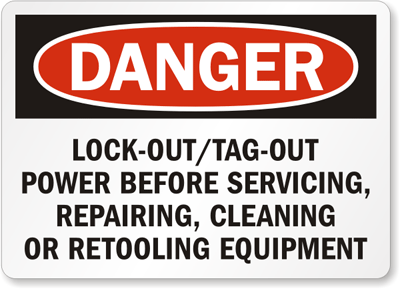
Universal Staffing Solutions, Inc. Helping Your Business Grow
5701 Truxtun Ave. Suite 220 Bakersfield, Ca. 93309 Tel: 661-432-7710 Fax: 661-432-7530
Safety Newsletter
Monthly Safety Meeting Newsletter
Safety Bulletin
Saving Lives with Lockout/Tagout
The federal lockout/tagout standard published by OSHA in 1989 was designed to prevent injuries and deaths caused by accidental start-up of equipment during maintenance or servicing. OSHA estimates that the lockout/tagout standard saves 122 lives and prevents 28,000 lost workday injuries each year. It's likely that well over 800 lives have been saved since the standard went into effect. That's more than 800 people who still go home to their families, friends, and loved ones; people who are there for the ones who depend on them. The lockout/tagout standard works. It saves lives. Yet unfortunate tragedies do still occur, but many of them could be prevented if the lockout/standard is applied correctly. This week's TailGate Topic provides a review of the lockout/tagout standard. Remember, the standard can only work if it's used correctly every time.
The lockout/tagout standard requires that hazardous energy sources be "isolated and rendered inoperative" before maintenance or servicing work can begin. These energy sources include electrical, pneumatic, hydraulic, mechanical, thermal, chemical, and the force of gravity. It is important to remember all of the energy sources must be "isolated and rendered inoperative." Overlooking an energy source has proved fatal on several occasions.
In order to "isolate and render inoperative" an energy source, an energy isolating device must be locked in place, or in certain cases, labeled with a tag warning against start-up of the equipment until servicing is finished. Stored energy sources, such as pressure, springs, and electricity contained in capacitors, must be released or "otherwise rendered safe" before servicing the equipment. Every person who will be working on the equipment applies a lock or tag to each energy isolating device. For complex equipment with many energy sources a group lockout is permitted.
After locks are applied, an attempt to re-start the equipment must be made to verify the equipment cannot be restarted before servicing begins. After servicing, each person who placed a lock or tag must remove it before the equipment is started.
OSHA regulations state three basic elements in a lockout/tagout program. These are training, written procedures, and inspections. Safety Training is required for two types of people-"authorized employees" and "affected employees." Authorized employees are people who do the maintenance or servicing work. They are the people who actually perform the lockout/tagout. Affected employees are people who may be affected by or work near equipment which is locked or tagged out. Affected employees are not permitted to perform servicing or maintenance work which requires a lockout or tagout.
Written Safety Procedures detailing the lockout/tagout procedure are required for equipment having two or more energy sources. Many companies require written lockout/tagout procedures for every piece of equipment, even those with only one energy source. Written procedures communicate important information to persons performing lockout/tagout. They identify energy sources, provide step-by-step instruction for locking or tagging out energy, releasing stored energy, and verifying the equipment cannot be re-started after lockout is applied. Group lockout/tagout procedures must also be clearly documented. Procedures must be kept up-to-date, and changes must be communicated to everyone who may possibly be affected by them. They are only useful if all the information they contain is correct.
Procedures for performing lockout/tagout must be followed consistently. Don't be tempted to take shortcuts for small jobs, even if the lockout/tagout procedure takes longer than the job itself!
Inspections of the lockout/tagout program must be performed annually. The lockout/tagout standard specifies who may perform the inspection. Typically it is an authorized employee who is not directly involved with the procedure being inspected. Periodic inspections or performing a mock safety audit or osha inspection provide an opportunity to verify procedures are being followed and correct deficiencies in the lockout/tagout program. Of course, if you are aware of any problems with the lockout/tagout program don't wait for a routine inspection, report them immediately.
These three elements of the lockout/tagout standard work together to keep you safe. Lockout/tagout saves lives and prevents injuries-if procedures are followed consistently and correctly. Never take a shortcut when it comes to your safety, especially when you're working with hazardous energy sources.
